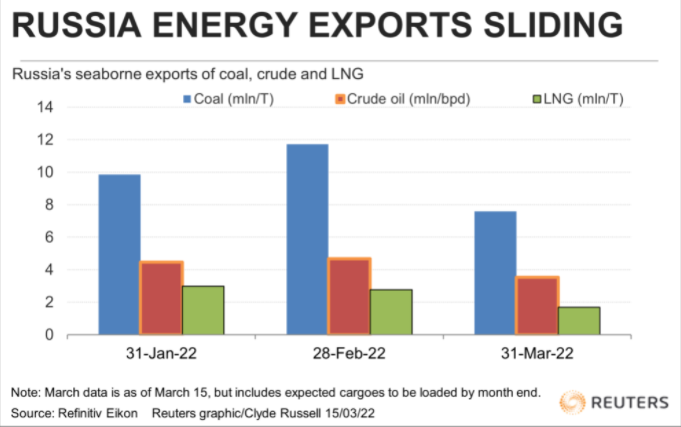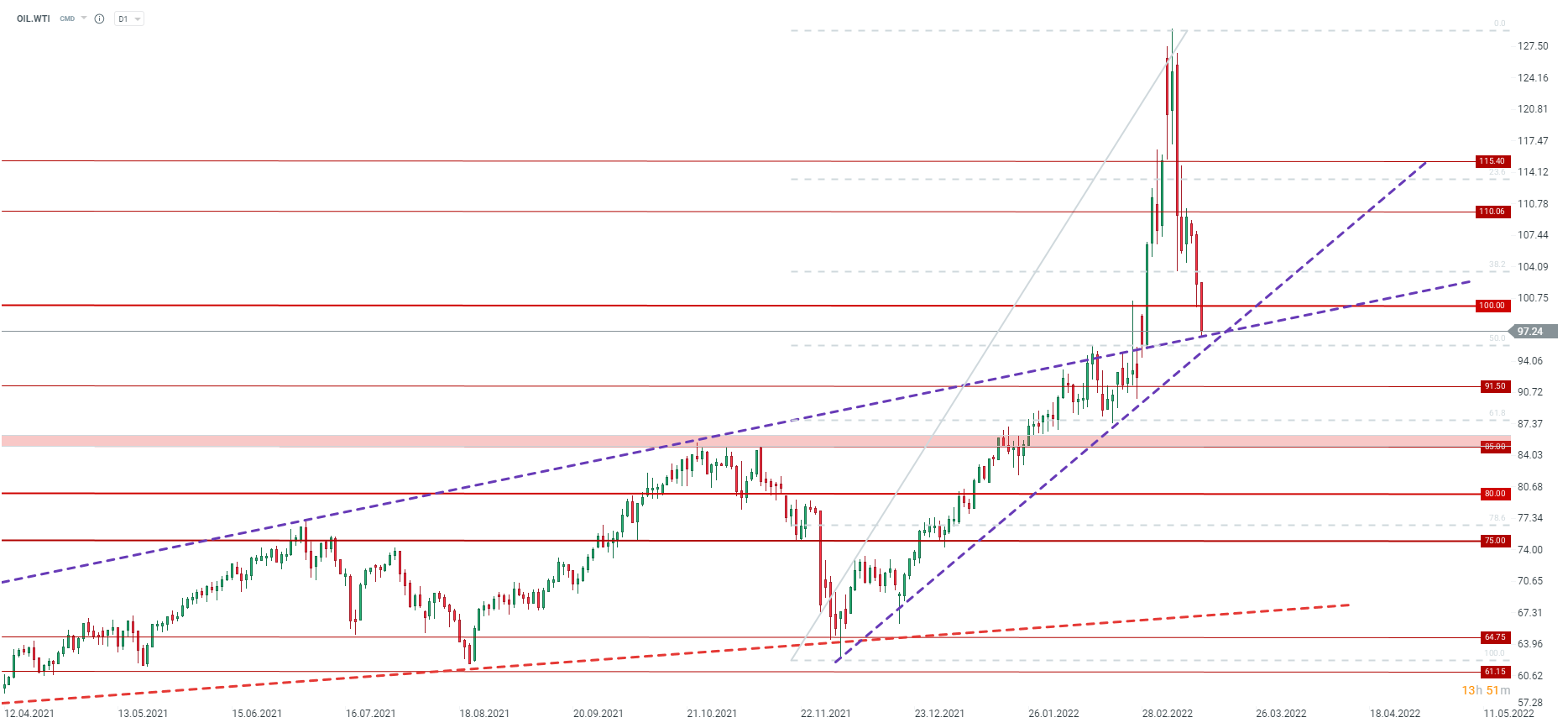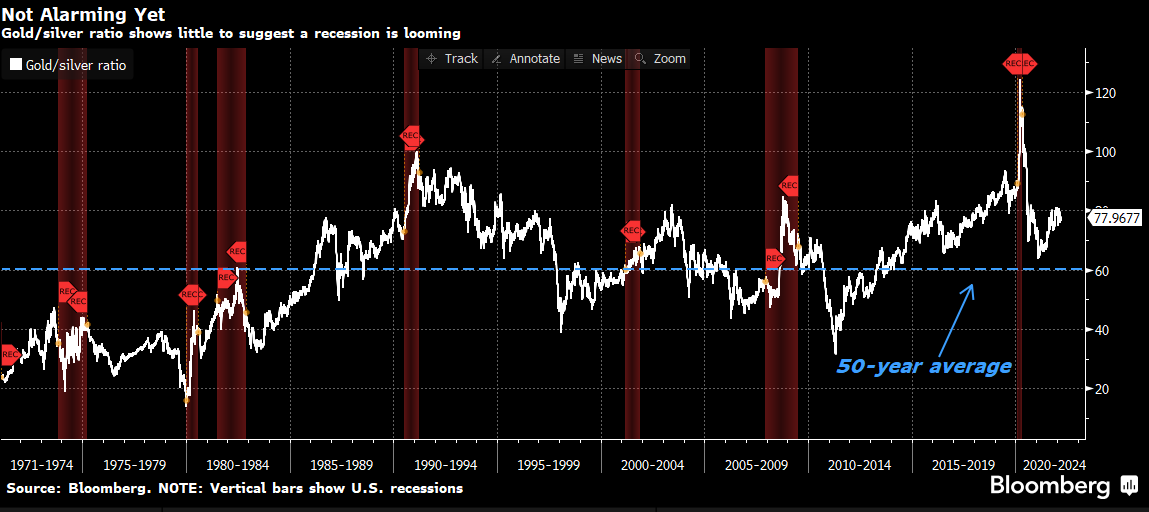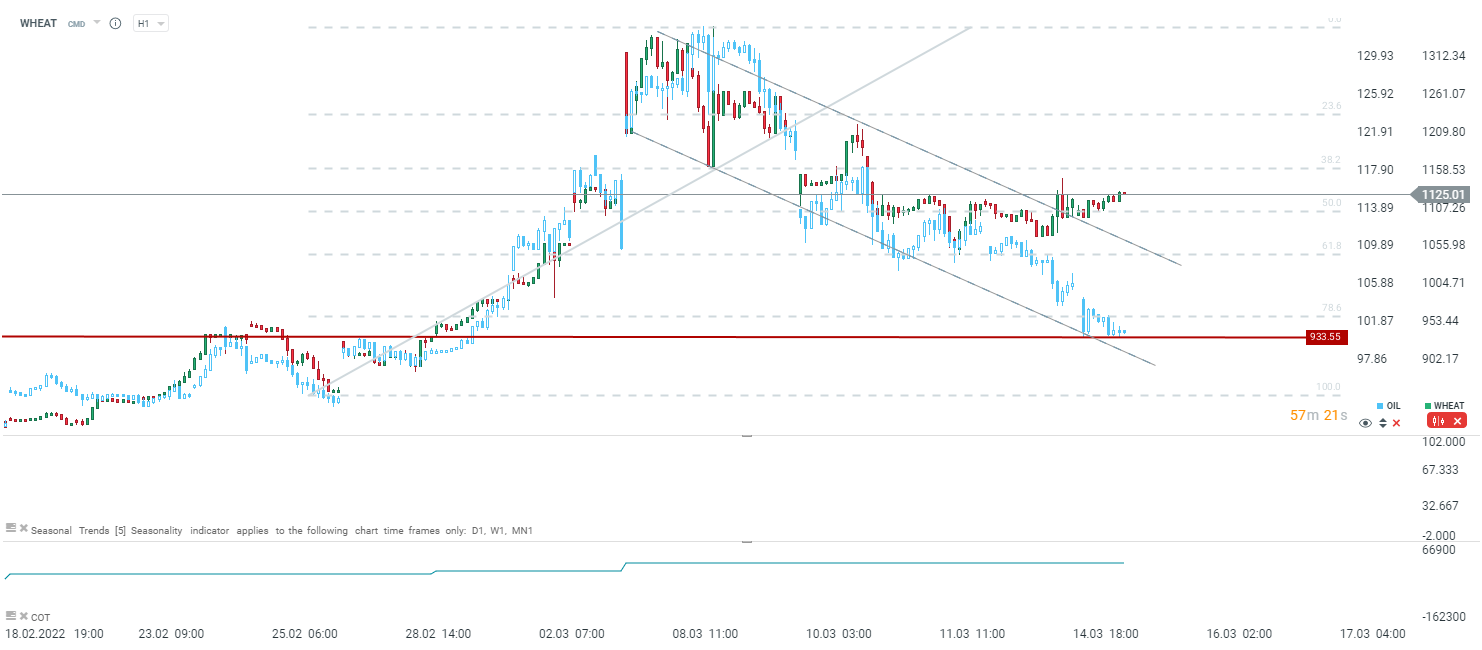Oil:
- The price of oil has returned to the level it was before the outbreak of the Russian war in Ukraine
- Mid-year call options at $ 150 per barrel remain very high, while call options at $ 200 per barrel have declined significantly
- Ukraine indicates that an agreement with Russia should be reached by May at the latest
- Significant increase in the number of Covid-19 cases in China, Beijing has not recorded an increase of more than 1000 cases in the last two years. If tighter restrictions are introduced, oil demand could respond
- Still, the situation is not very optimistic, looking at the prospect of a return to lower prices
- India may see an increase in demand this year of over 200,000 bpd
- The decline in exports from Russia is already visible, based on Reuters calculations (chart)
- The Iran nuclear deal is not certain: the United States hesitates because it does not want to grant more sanctions waivers than under the 2015 agreement. Russia, in turn, blocks the deal because it wants to access that market (no sanctions).
- Brent trades around $ 100.00, WTI around $ 96.00
 Crude oil call options at 200 have depreciated significantly, which shows that the market does not believe that price can rise to this level. Source: Bloomberg
Crude oil call options at 200 have depreciated significantly, which shows that the market does not believe that price can rise to this level. Source: Bloomberg
Start investing today or test a free demo
Create account Try a demo Download mobile app Download mobile app Crude oil call options at 200 have depreciated significantly, which shows that the market does not believe that price can rise to this level. Source: Bloomberg
Crude oil call options at 200 have depreciated significantly, which shows that the market does not believe that price can rise to this level. Source: Bloomberg
 Crude oil trades around $96-97 per barrel. This is a major support zone, which is marked with 50.0% Fibonacci retracement of the last upward impulse and two uptrend lines. Source: xStation5
Crude oil trades around $96-97 per barrel. This is a major support zone, which is marked with 50.0% Fibonacci retracement of the last upward impulse and two uptrend lines. Source: xStation5
Silver:
- In line with the seasonality, silver price is falling. The bottom should be marked next week.
- Positive positioning on silver is growing strongly. The number of long positions is increasing, the number of short positions is decreasing.
- At the same time, ETFs have been selling silver since the beginning of the war in Ukraine
- The gold to silver ratio does not suggest that we could be dealing with a recession / crisis signal. In previous cases, we saw a strong increase in the price ratio
- It is worth remembering that after the first interest rate hike in the US, precious metals usually gained, at least in the perspective of six months. However, the risk of a 50 bp hike in May is rising, which may weigh on the bullish scenario.
- At the same time, the market sees a chance that the Fed will stop further tightening and start lowering interest rates as early as the middle of next year, similar to what happened in mid-2018, when precious metals launched a long-term rally.
 Net positioning is growing, it is at its highest since mid-2021. At the same time, however, ETFs have been selling silver since the beginning of the war in Ukraine. Source: Bloomberg
Net positioning is growing, it is at its highest since mid-2021. At the same time, however, ETFs have been selling silver since the beginning of the war in Ukraine. Source: Bloomberg
 Gold / silver price ratio does not indicate an increased risk of a recession. Source: Bloomberg
Gold / silver price ratio does not indicate an increased risk of a recession. Source: Bloomberg
Coffee:
- Inventories are increasing slowly, net positioning is at the lowest level in 5 months
- The speculators are leaving the market before the harvest season begins
- Brazil's coffee exports fell in February on an annualized basis, but rebounded on a monthly basis
- Traders point to diminishing problems in terms of coffee deliveries around the world
- The harvest will begin next week in Brazil, which could boost global supply and trigger further declines in the short term. On the other hand, the first data will show whether worries about low yields are justified.
 Brazil's exports are worse than a year ago, but have rebounded compared to January. Exports are still above the 5-year average. Source: Bloomberg
Brazil's exports are worse than a year ago, but have rebounded compared to January. Exports are still above the 5-year average. Source: Bloomberg
 Long positions have declined sharply. However, there is no rebound in short positions, which could still mean that speculators are reluctant to open positions before the harvest begins. The decline in long positions is a result of profit taking. Source: Bloomberg
Long positions have declined sharply. However, there is no rebound in short positions, which could still mean that speculators are reluctant to open positions before the harvest begins. The decline in long positions is a result of profit taking. Source: Bloomberg
Wheat:
- Ban on the export of wheat from Russia to the countries of the Eurasian Union (former USSR countries)
- However, this accounts for a maximum of 10% of all Russian exports. Exports to key buyers like Egypt and Turkey remain intact
- The price rebounds slightly, after buyers managed to stop the decline around support at 1,050 cents a bushel
- Deliveries from Russia through the Black Sea ports remain intact
- According to APK-Inform, the sowing of wheat, corn and sunflowers in Ukraine may be about 40% lower compared to last year
- However, further export bans from Russia cannot be ruled out
 The wheat price continues to increase due to the uncertainty regarding harvest season. On the other hand, the relative costs (oil prices) are falling, which creates a clear divergence. One should also remember about the export ban on fertilizers from Russia, which may result in higher production costs. Source: xStation5
The wheat price continues to increase due to the uncertainty regarding harvest season. On the other hand, the relative costs (oil prices) are falling, which creates a clear divergence. One should also remember about the export ban on fertilizers from Russia, which may result in higher production costs. Source: xStation5
This content has been created by XTB S.A. This service is provided by XTB S.A., with its registered office in Warsaw, at Prosta 67, 00-838 Warsaw, Poland, entered in the register of entrepreneurs of the National Court Register (Krajowy Rejestr Sądowy) conducted by District Court for the Capital City of Warsaw, XII Commercial Division of the National Court Register under KRS number 0000217580, REGON number 015803782 and Tax Identification Number (NIP) 527-24-43-955, with the fully paid up share capital in the amount of PLN 5.869.181,75. XTB S.A. conducts brokerage activities on the basis of the license granted by Polish Securities and Exchange Commission on 8th November 2005 No. DDM-M-4021-57-1/2005 and is supervised by Polish Supervision Authority.
